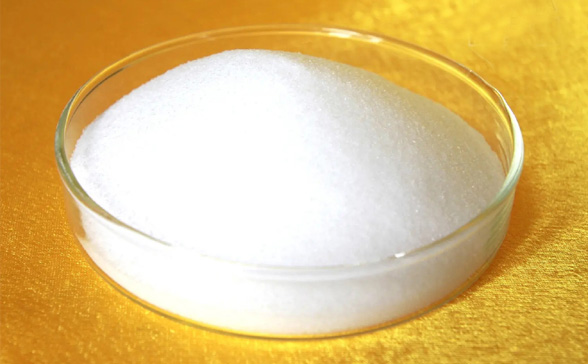
Product ingredients
Chemical name: Carbohydrazide, Carbohydrazide
CAS: 497-18-7
Molecular formula: N4H6CO
Formula:


Scope of application
Carbohydrazide is a white crystalline powder, which is very soluble in water, insoluble in alcohol, ether, and benzene. Since it is a derivative of hydrazine and has strong reducing properties, carbohydrazide has a wide range of uses in industry. In the field of water treatment, it can be used as a deoxidizer for boiler water; it can also be used as a component of rocket propellants; and because the hydrogen atoms connected to nitrogen atoms are easily replaced by other groups, in the textile industry, it can also be used as a crosslinking agent for elastic fibers, a formaldehyde scavenger, and an antioxidant for pigments such as carotene. In addition, adding an appropriate amount of carbohydrazide to soap containing phenolic fungicides can prevent discoloration and rancidity. This product is non-toxic. It can replace hydrazine hydrate and oximes. It can be used as an intermediate for the manufacture of energetic materials, and can also be directly used as a component of rocket explosives and propellants. Carbohydrazide can also be used as a crosslinking agent for elastic fibers in the chemical fiber industry. As a chemical raw material and chemical intermediate, it is widely used in medicine, herbicides, plant growth regulators, dyes and other industries. As a deoxidizer for boiler water, it has low toxicity, high melting point and excellent deoxidation efficiency. It is a widely used, safe and environmentally friendly ideal product.
Product advantages
Water treatment industry, used for boiler deoxidation; this product is better than traditional hydrazine hydrate and oxime (acetaldehyde oxime, etc.) deoxidation. Traditional hydrazine hydrate and acetaldehyde oxime deoxidation produce a large amount of organic wastewater containing hydrazine (excessive addition of hydrazine hydrate) and aldehydes after deoxidation. The treatment of these wastewaters requires a lot of manpower, material and financial resources, and is not environmentally friendly. This product reacts with oxygen to produce nitrogen, water and carbon dioxide, and excessive addition will not cause harm to the environment. Since no organic chemicals are produced, the subsequent boiler wastewater treatment is more environmentally friendly, and the deoxidation efficiency of this product is twice that of hydrazine hydrate and oxime products. Their reactions are as follows:
Carbohydrazide reacts with oxygen as follows:
N4H6CO+2O2=2N2+3H2O+CO2Hydrazine
hydrate reacts with oxygen as follows:
N2H4.H2O+O2=N2+3H20Acetaldehyde
oxime reacts with oxygen as follows:
2C2H5NO+O2=2CH3C0H+N2O+H2OFrom
the above reaction equation, it can be seen that although this product and hydrazine hydrate react to produce only gas and water, hydrazine hydrate itself is a carcinogen. If it is added in excess, it will have an impact. The wastewater containing hydrazine hydrate must be treated later, and the deoxygenation efficiency is the lowest among the three products. Deoxygenation is already an obsolete product abroad. The deoxygenation efficiency of acetaldehyde oxime is higher than that of hydrazine hydrate, but acetaldehyde oxime reacts with oxygen to produce acetaldehyde, while this product only produces nitrogen and carbon dioxide, and the deoxygenation efficiency of this product is higher than that of acetaldehyde oxime.
In terms of deoxygenation efficiency, carbohydrazide > acetaldehyde oxime > hydrazine hydrate
In terms of environmental protection, carbohydrazide > hydrazine hydrate > acetaldehyde oxime
In terms of toxicity, hydrazine hydrate > acetaldehyde oxime > carbohydrazide
As a new type of deoxygenator, carbohydrazide is widely welcomed in Europe and the United States. This new type of deoxygenator is not only more efficient in deoxygenation, but more importantly, it is non-toxic, safer to use, and more environmentally friendly.
The reaction of hydrazine hydrate and oxygen is as follows:
N2H4.H2O+O2=N2+3H2O
The reaction of acetaldehyde oxime and oxygen is as follows:
2C2H5NO+O2=2CH3COH+N2O+H2O
Physical and chemical index and factory inspection index
| Characteristics | Specification | Test Value |
| Appearance | White crystal line powder | White crystal |
| Active content.% | 99.0Min | 99.9% |
| PH(12%solution).25℃ | 7.2-9.7 | 8.43 |
| Free hydrazine,ppm | 250±50 | 237 |
| Chloride ppm | 10Max | 8.0 |
| Sulfate, ppm | 20Max | 10 |
| Copper, ppm | 1.0Max | <0.5 |
| Moisture,% | 0.2Max | 0.3 |
| Silica.ppm | 10.0Max | 2.4 |
| Iron,ppm | 4.0Max | 0.62 |
| Na.ppm | 4.0Max | <1 |
| Pb.ppm | 4.0Max | <1 |
| Turbidity (12% in Dlwater) | 4.0Max | 0.4 |
Note: The allowable error range of free hydrazine detection is ±50
. Index
| Residual hydrazine, ppm, ≤ | 500±50 Excellent grade ZQL-6001 |
| Residual hydrazine, ppm, ≤ | 250±50 Special Grade ZQL-6000 |
| Residual hydrazine, ppm, ≤ | 750±50 Grade 1 ZQL-6002 |
Usage and Dosage
It can be prepared into a 10% aqueous solution (appropriately proportioned according to the amount of free oxygen in the aqueous solution) and
mixed with solids on site. It should be prepared immediately before use Packaging
and Storage
Cardboard barrel packaging, net weight 25KG or
25KG plastic barrel packaging according to customer requirements, 10% aqueous solution
Store in a cool and ventilated place indoors, storage period 18 months
Safety Matters
When transferring this product, you should wear protective equipment. If contaminated, wash immediately with plenty of water.
-
Next:None
- Back
-
Prev:Dimethyl Maleate
